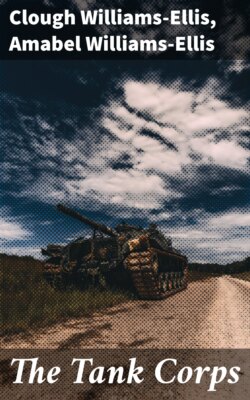Читать книгу The Tank Corps - Clough Williams-Ellis - Страница 22
На сайте Литреса книга снята с продажи.
I
ОглавлениеTable of Contents
Though plans for expansion and the complete reorganisation of the unit on a large scale had been begun directly after the results of the action of September 15 were known, little of the actual work of training could be started till the end of November, when the “veteran” Tank personnel were at last available as instructors. They were, as we have said, withdrawn on November 19 and moved to the Bermicourt area, which had been already prepared for them.
They were the leaven—less than one “old” Company to each new Battalion—who must impart their knowledge and experience to the new men.
A subaltern who had seen any fighting with the Tanks would suddenly find himself regarded as the greatest living expert on some obscure technical point, and the newly joined who had never seen a Tank “looked with awe upon these battle-tried warriors.”
Men and officers were allowed to volunteer for the Tank Corps from other units either in France or at home. The notion of fighting in a Tank was popular, for on many of the men of the old arms—especially the infantry—the ordinary battle routine had—to put it conservatively—begun to pall.
Therefore, there was no difficulty as to supplies of men whenever the authorities turned the tap.
15“We came from the infantry, from the cavalry, from the artillery, from the Machine Gun Corps, the Motor Machine Gun Corps, the Flying Corps, the Army Service Corps, and even from the Navy.”
At first each individual wore the dress of his original unit, so that there was a strange collection of uniforms at Bermicourt—Scottish bonnets and kilts, riding breeches, and bandoleers, every conceivable dress, even to naval blue.
15“The spirit of adventure called us to the Tanks ... and so the call for volunteers found us ready, and when the word of acceptance came, our hearts beat quickly and our hopes were high ... some of us were selected because we were machine-gunners, and others because we were motor drivers. But there were many of us to whom the machine-gun and the motor were incomprehensible things. But in the end we did not find this lack of knowledge any handicap; for the Army authorities, who were wiser than we, knew that to men of average intelligence these things were easy to learn; and to our very great amazement we found that a week was all that was necessary thoroughly to master any machine-gun ... and that it only took us two weeks to grasp the principle of the internal combustion engine and the mechanism of the Tank.”
At Bermicourt and at Wool the deficiencies of the old Thetford training were realised. The experience gained on the Somme had been assimilated. Instructors now knew exactly what they must teach, and this time the spirit of the course of training was definite and businesslike.
The whole scheme was most carefully planned to ensure a proper balance, and the right amount of time was allotted to the different courses.
At first the work consisted chiefly in the training of more instructors, for the expansion of the Corps was to be rapid. The “settings” of all the courses showed great advances on the Thetford model, for at last the practice grounds could be made to resemble the actuality. There were old trenches and shell and mine craters, and the men were at once taken over bad ground, until the conditions of this curious progress became things of custom.
16“There is not one of us who will ever forget his first ride—the crawling in at the sides, the discovery that the height did not permit a man of medium stature to stand erect, the sudden starting of the engine, the roar of it all when the throttle opened, the jolt forward, and the sliding through the mud that followed, until at last we came to the ‘jump’ which had been prepared. Then came the downward motion, which suddenly threw us off our feet and caused us to stretch trusting hands toward the nearest object—usually, at first, a hot pipe through which the water from the cylinder jackets flowed to the radiator. So, down and down and down, the throttle almost closed, the engine just ‘ticking over,’ until at last the bottom was reached, and as the power was turned full on, the Tank raised herself to the incline, like a ship rising on a wave, and we were all jolted the other way, only to clutch again frantically for things which were hot and burned, until at last, with a swing over the top, we gained level ground. And in that moment we discovered that the trenches and the mud and the rain and the shells and the daily curse of bully beef had not killed everything within, for there came to us a thrill of happiness in that we were to sail over stranger seas than man had ever crossed, and set out on a great adventure.”
The necessity of regularising and systematising the Reconnaissance Branch had not been forgotten, and a separate Reconnaissance Service—really a specially adapted branch of “Intelligence”—was set up, under Major Hotblack.
The first organised work of the Branch was to be done in the preparations for the Battle of Arras, and it is at that period that we shall see the tentative beginnings of the very special system which was later on developed.
For the present “Reconnaissance” spent its time lecturing and being lectured, and in preparing maps or training areas for theoretical or practical exercises in the new art of Tank warfare.
